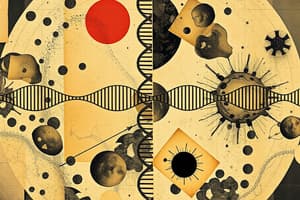Podcast
Questions and Answers
During the S phase of interphase, chromosomes replicate but remain ______.
During the S phase of interphase, chromosomes replicate but remain ______.
uncondensed
Homologous chromosomes come together during Prophase I in a process called ______.
Homologous chromosomes come together during Prophase I in a process called ______.
synapsis
Each tetrad has one or more ______ that hold homologs together.
Each tetrad has one or more ______ that hold homologs together.
chiasmata
In Anaphase I, homologous chromosomes are pulled toward opposite ______.
In Anaphase I, homologous chromosomes are pulled toward opposite ______.
During Telophase II, the chromosomes ______ and uncoil.
During Telophase II, the chromosomes ______ and uncoil.
During metaphase I of meiosis, homologous pairs of chromosomes orient randomly due to ______.
During metaphase I of meiosis, homologous pairs of chromosomes orient randomly due to ______.
The number of combinations possible during independent assortment is determined by the formula 2n, where n is the ______ number.
The number of combinations possible during independent assortment is determined by the formula 2n, where n is the ______ number.
Crossing over occurs during Prophase I and results in ______ chromosomes.
Crossing over occurs during Prophase I and results in ______ chromosomes.
The likelihood of crossing over between two genes increases as the distance between those genes ______.
The likelihood of crossing over between two genes increases as the distance between those genes ______.
The frequency of crossing over is measured in ______ units, which denote the distance between genes.
The frequency of crossing over is measured in ______ units, which denote the distance between genes.
Somatic cells are any body cells other than a sperm or an ______.
Somatic cells are any body cells other than a sperm or an ______.
Human somatic cells contain ______ chromosomes.
Human somatic cells contain ______ chromosomes.
Gametocytes are reproductive cells, commonly known as ______ and egg.
Gametocytes are reproductive cells, commonly known as ______ and egg.
Gametocytes are ______ cells, containing a single set of chromosomes.
Gametocytes are ______ cells, containing a single set of chromosomes.
Human gametes contain ______ chromosomes.
Human gametes contain ______ chromosomes.
Meiosis is a cell division process resulting in daughter cells with only half the ______ material of the original cell.
Meiosis is a cell division process resulting in daughter cells with only half the ______ material of the original cell.
In plants, meiosis results in haploid ______.
In plants, meiosis results in haploid ______.
The fused cell, known as a ______, is formed during fertilization.
The fused cell, known as a ______, is formed during fertilization.
Each cell has a haploid set of ______ (unreplicated)
Each cell has a haploid set of ______ (unreplicated)
Spermatogenesis occurs in the ______; begins at puberty.
Spermatogenesis occurs in the ______; begins at puberty.
Oogenesis is the development of ______ in ovaries.
Oogenesis is the development of ______ in ovaries.
Mitosis produces somatic cells which are ______.
Mitosis produces somatic cells which are ______.
Meiosis produces gametes which are ______.
Meiosis produces gametes which are ______.
In meiosis, independent assortment of ______ contributes to genetic variation.
In meiosis, independent assortment of ______ contributes to genetic variation.
One mechanism contributing to genetic variation during meiosis is ______ over.
One mechanism contributing to genetic variation during meiosis is ______ over.
The behavior of chromosomes during meiosis and ______ is responsible for variation.
The behavior of chromosomes during meiosis and ______ is responsible for variation.
Polyploidy might be a desired trait in crops, ornamental plants because it leads to more robust plants with larger ______, fruits, and seeds.
Polyploidy might be a desired trait in crops, ornamental plants because it leads to more robust plants with larger ______, fruits, and seeds.
The cultivated banana is believed to have been derived from a cross between a diploid species Musa acuminata and the ______ species M. balbisiana.
The cultivated banana is believed to have been derived from a cross between a diploid species Musa acuminata and the ______ species M. balbisiana.
Chromosomal mutations contribute to variation, mostly undesirable changes in phenotype, especially if they result in the loss of function of ______ or DNA sequences.
Chromosomal mutations contribute to variation, mostly undesirable changes in phenotype, especially if they result in the loss of function of ______ or DNA sequences.
The fly Drosophila mangabeirai has a unique reproductive method where one of the polar bodies acts as a sperm and 'fertilizes' the ______.
The fly Drosophila mangabeirai has a unique reproductive method where one of the polar bodies acts as a sperm and 'fertilizes' the ______.
In bees, wasps, and ants, unfertilized haploid eggs develop into ______.
In bees, wasps, and ants, unfertilized haploid eggs develop into ______.
Propagation of the cultivated banana occurs by dividing its ______ system.
Propagation of the cultivated banana occurs by dividing its ______ system.
Grasshopper Pycnoscelus surinamensis forms a diploid egg by two ______ divisions.
Grasshopper Pycnoscelus surinamensis forms a diploid egg by two ______ divisions.
Deletion, duplication, inversion, and translocation are types of chromosomal ______.
Deletion, duplication, inversion, and translocation are types of chromosomal ______.
1 map unit = 1% ______ Frequency (crossover)
1 map unit = 1% ______ Frequency (crossover)
Genes are 'linked' if RF% < ______%
Genes are 'linked' if RF% < ______%
The fusion of two gametes produces a zygote with about ______ trillion diploid combinations.
The fusion of two gametes produces a zygote with about ______ trillion diploid combinations.
Nondisjunction can lead to ______, which is an abnormal number of chromosomes.
Nondisjunction can lead to ______, which is an abnormal number of chromosomes.
Turner’s Syndrome is an example of ______ due to nondisjunction.
Turner’s Syndrome is an example of ______ due to nondisjunction.
Down Syndrome is also known as ______ 21.
Down Syndrome is also known as ______ 21.
Most organisms are either diploid (2n) or ______ (n).
Most organisms are either diploid (2n) or ______ (n).
Triploid organisms have ______ sets of chromosomes.
Triploid organisms have ______ sets of chromosomes.
Flashcards
Somatic Cells
Somatic Cells
Any cells in the body that are not sperm or egg cells.
Gametes
Gametes
Reproductive cells, such as sperm and egg cells.
Diploid (2n)
Diploid (2n)
A cell that contains two sets of chromosomes, one from each parent.
Haploid (n)
Haploid (n)
Signup and view all the flashcards
Homologous Chromosomes
Homologous Chromosomes
Signup and view all the flashcards
Meiosis
Meiosis
Signup and view all the flashcards
Development
Development
Signup and view all the flashcards
Fertilization
Fertilization
Signup and view all the flashcards
What happens during the S phase of interphase?
What happens during the S phase of interphase?
Signup and view all the flashcards
What is Synapsis?
What is Synapsis?
Signup and view all the flashcards
What is a Tetrad?
What is a Tetrad?
Signup and view all the flashcards
What is Crossing Over?
What is Crossing Over?
Signup and view all the flashcards
What are Chiasmata in Meiosis?
What are Chiasmata in Meiosis?
Signup and view all the flashcards
Spermatogenesis
Spermatogenesis
Signup and view all the flashcards
Oogenesis
Oogenesis
Signup and view all the flashcards
Synapsis
Synapsis
Signup and view all the flashcards
Crossing over
Crossing over
Signup and view all the flashcards
Independent assortment
Independent assortment
Signup and view all the flashcards
Mutations
Mutations
Signup and view all the flashcards
Combinations from Independent Assortment
Combinations from Independent Assortment
Signup and view all the flashcards
Gene Distance and Crossing Over
Gene Distance and Crossing Over
Signup and view all the flashcards
Random Fertilization
Random Fertilization
Signup and view all the flashcards
Polyploidy
Polyploidy
Signup and view all the flashcards
Triploid
Triploid
Signup and view all the flashcards
Tetraploid
Tetraploid
Signup and view all the flashcards
Deletion
Deletion
Signup and view all the flashcards
Duplication
Duplication
Signup and view all the flashcards
Inversion
Inversion
Signup and view all the flashcards
Translocation
Translocation
Signup and view all the flashcards
Parthenogenesis
Parthenogenesis
Signup and view all the flashcards
Recombination Frequency
Recombination Frequency
Signup and view all the flashcards
Linked Genes
Linked Genes
Signup and view all the flashcards
Test Cross
Test Cross
Signup and view all the flashcards
Zygote
Zygote
Signup and view all the flashcards
Nondisjunction
Nondisjunction
Signup and view all the flashcards
Aneuploidy
Aneuploidy
Signup and view all the flashcards
Study Notes
Meiosis
- Meiosis is a type of cell division that produces haploid cells (gametes or spores) from a diploid cell
- The process reduces the chromosome number by half, essential for sexual reproduction
- Meiosis involves two rounds of cell division (Meiosis I and Meiosis II)
- Interphase occurs before meiosis, including G1, S, and G2 phases, like mitosis, with DNA replication in S phase
Cell Types
- Somatic cells are any body cells other than sperm or egg, diploid (two sets of chromosomes), Humans have 46 chromosomes
- Gametes (sperm and egg) are reproductive cells, haploid (one set of chromosomes), Humans have 23 chromosomes
Meiosis Stages
-
Meiosis I involves separation of homologous chromosomes
- Prophase I: Chromatin condenses, homologous chromosomes pair up (synapsis), forming tetrads, crossing over occurs
- Metaphase I: Tetrads line up at the metaphase plate
- Anaphase I: Homologous chromosomes separate and move to opposite poles
- Telophase I and Cytokinesis: Chromosomes arrive at poles, cytoplasm divides, forming two haploid daughter cells.
-
Meiosis II involves separation of sister chromatids
- Prophase II: Chromosomes condense, nuclear envelope breaks down
- Metaphase II: Chromosomes line up at the metaphase plate
- Anaphase II: Sister chromatids separate and move to opposite poles
- Telophase II and Cytokinesis: Chromosomes arrive at poles, cytoplasm divides, forming four haploid daughter cells
Spermatogenesis
- Development of sperm in the testes, begins at puberty
- A series of stages leading to mature sperm, involving meiosis I and meiosis II
Oogenesis
- Development of oocytes (eggs) in the ovaries
- Oocytes begin forming before birth, remain in prophase I until female matures
- Only 1 ovum (egg) is formed, other products are polar bodies
- One egg is released per cycle
- Complete meiosis II only if fertilized
Mitosis vs Meiosis
| Feature | Mitosis | Meiosis |
|---|---|---|
| Location | All tissues | Only in testis/ovaries |
| Products | Somatic cells (diploid) | Gametes (haploid) |
| DNA replication | 1 | 1 |
| Cell division | 1 | 2 |
| Chromosome number | Same | Half |
| Genetic variation | No | Yes |
| Timing | Short | Can be months/years (depending on organism) |
Genetic Variation
- Mutations are the primary source of genetic diversity
- Three mechanisms contribute to genetic variation in meiosis:
- Independent assortment of chromosomes: Homologous pairs align randomly at metaphase I
- Crossing over: Non-sister chromatids exchange genetic material in prophase I
- Random fertilization: Any sperm can fuse with any egg, leading to unique combinations
Meiotic Errors
- Nondisjunction: Failure of homologous chromosomes or sister chromatids to separate during anaphase I or II
- Leads to aneuploidy (abnormal chromosome number), such as trisomy (extra chromosome) or monosomy (missing chromosome)
Polyploidy
- Triploid (3n) and tetraploid (4n) are possible, with more sets of chromosomes
- This can occur due to errors in cell division (extra DNA replication or lack of spindle formation)
- Can lead to reproductive isolation or new species formation
Chromosomal Mutations
- Deletion, duplication, inversion, translocation (rearrangement) of chromosome segments
- Usually not advantageous for organism survival due to loss of gene function or DNA sequences.
Studying That Suits You
Use AI to generate personalized quizzes and flashcards to suit your learning preferences.




